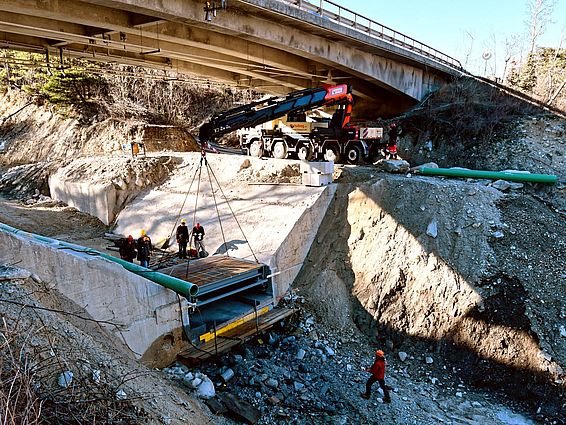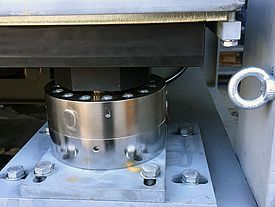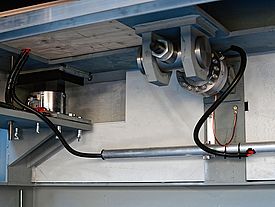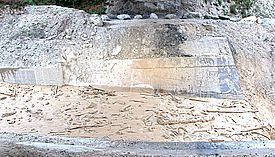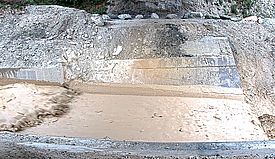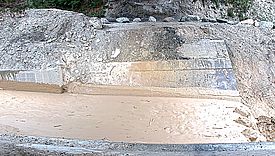In summer 2016, a debris-flow transporting huge boulders destroyed the measuring system installed in the Illgraben gully near Leuk (canton of Valais). The equipment, which is operated by the Swiss Federal Institute for Forest, Snow and Landscape Research (WSL), has now been replaced with a technically superior version. On June 10, the upgraded facility successfully withstood its first large debris-flow and provided more accurate measurements and videos than the previous system, with a higher temporal resolution.
Like its predecessor, the new measuring system consists of a force plate, supported on a steel frame, and six load cells. It is installed in a concrete check dam so that when a debris-flow – a rapidly flowing mixture of mud and rock – comes thundering down the channel, it is forced to flow over the plate in a uniform manner. The measurements are used to make a detailed assessment of the flow and to measure such as the density of the debris flow, which is close to that of flowing concrete.
The new measuring system, developed by the Swiss Federal Research Institute WSL and the WSL Institute for Snow and Avalanche Research (SLF), will carry on the unique series of measurements collected over 13 years by its predecessor, and thanks to the latest measuring technology will even provide even better data quality.
High-tech solution in the Valais Rhone valley
The old debris-flow scale, which was the first of its kind anywhere in the world when it was built in 2003, provided comprehensive data on the dynamic forces of a total of 50 debris bearing floods and debris-flows in the Illgraben until its destruction in 2016 (see box). During the recently completed upgrade, the researchers optimized the technical equipment. The centerpiece of the facility is the 8 m2 steel plate, embedded in concrete, beneath which are mounted six load cells that record the vertical and horizontal forces of a debris-flow in high resolution. In addition, radar and laser devices, acceleration sensors on the force plate and video cameras provide data about the volume, water content, density and velocity of the debris-flow.
This allows conclusions to be drawn about the particle size distribution and the amount of water in the debris flow. Before installation, the researchers tested the new system in the laboratory under controlled conditions, provided data on the performance of the measuring system. This included findings from model measurements measured on small, artificial debris-flows.
The first debris-flow of 2019
Located in the same place as its predecessor, the new measuring system was put through its paces on June 10, 2019 during the first debris-flow of the year. All the measuring devices and the automatic video camera worked as expected, providing all the required measurements – a great success for the team of scientists and engineers. The current debris-flow was of relatively low magnitude and swept around 5,000 m3 of rock material from the Illgraben catchment down into the valley, into the River Rhone.
And this is what the new system measured: it detected the debris-flow on June 10, 2019 at 8:40 p.m. about 140 m upstream of the measuring system. A good 3 minutes later, its front reached the new measuring plate at a speed of just under 5 km/h. The density of the mixture of mud and rock resembled that of liquid concrete; its maximum height was only 70 cm. The debris-flow transported a lot of wood, typical for the first event after winter. Although it flowed very slowly, the video recordings showed about 20 waves or surges, a well-known phenomenon for such a mixture. The event lasted about 30 minutes. Subsequently, a narrow stream fed by meltwater flowed through the channel again, as is usual in the evening hours at the beginning of June.
Natural hazard research put to practical use
With the new measuring system, the WSL researchers aim to answer one of the fundamental questions of debris-flow research: how great is the friction during a debris-flow, and how does this change over the course of the event? The main objective is to improve our understanding of the flow dynamics of debris-flows, in particular the interaction between water and entrained rocks and sediments. Knowing the answer to this question will make it possible to determine the velocity of a debris-flow more accurately and to calculate the expected flow volume, even in channels where no measuring instruments are installed.
The knowledge gained at the Illgraben will help natural hazard experts in mountain regions to design optimal protective structures, produce more accurate hazard maps and make protective measures more effective. One aim of the research is to better understand the variability of debris flows (how fast, how deep, how much sediment) to support practitioners who optimize structures such as sediment barriers, which retain coarse rock material, so that debris-flows decrease in intensity as they move downhill and pose less of a threat to people and infrastructure.
For safety reasons, WSL experts still recommend installing warning systems such as the one in the lower reaches of the Illgraben, in cases where roads need to be closed or people, often tourists, need to be evacuated when a debris flow has been detected. There, measuring devices in the upper reaches of the gully detect a newly formed debris-flow, which immediately triggers sirens and hazard lights lower down the channel to warn of the impending danger.
The Illgraben is one of the most active debris-flow channels in the Alps, experiencing an average of three to five debris-flows of varying magnitudes between May and October each year. The largest recorded debris-flow in recent times occurred in 1961 and had a volume of several hundred thousand cubic meters. The Illgraben catchment extends from the summit of the Illhorn (2,717 m) to the confluence with the River Rhone (605 m). For this reason, WSL began building an observation facility for natural debris-flows here in the year 2000, in close cooperation with the Canton of Valais and the Federal Office for the Environment (FOEN). The mean volume of the debris-flows measured to date is 25,000 m3, with the largest being more than 100,000 m3. There are now similar facilities in North America and Japan, which are also used for research purposes. However, their measuring plates are either smaller than those at the Illgraben or do not measure along the entire width of the stream. The new facility is the only one in the world that can provide data of this quality and abundance.
The original force plate was destroyed by a debris-flow on 22 July 2016. This event was not exceptional in terms of total volume and flow velocity; what made it unusual were three huge boulders, each measuring over 30 m3, entrained at the front of the flow, which tore the force plate from its supporting structure and carried it down the gully. The three-ton plate was later found several hundred meters away on the bed of the Rhone.
Contact
Links and documents
Copyright
WSL and SLF provide image and sound material free of charge for use in the context of press contributions in connection with this media release. The transfer of this material to image, sound and/or video databases and the sale of the material by third parties are not permitted.
